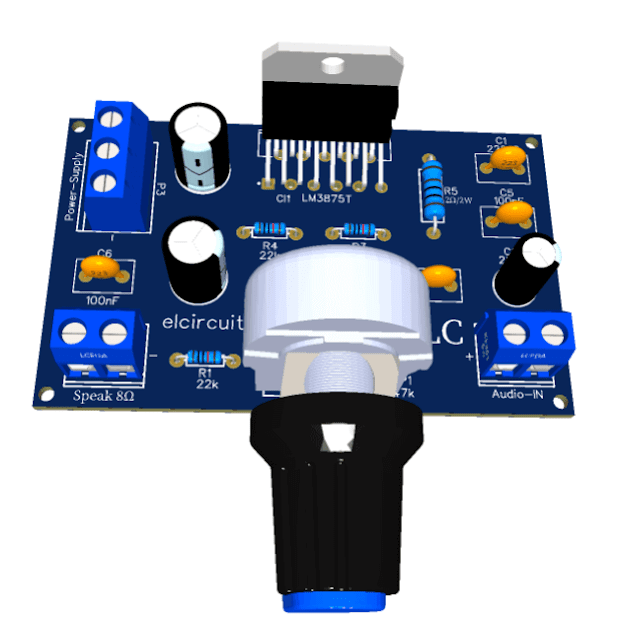56W RMS Hi-FI Amplifier using LM3875 Integrated Circuit + PCB
For Portuguese version, click here!
High-performance Hi-FI Audio Amplifier, capable of producing excellent audio quality, using the LM3875 integrated circuit.
The LM3875 is a high-performance power audio amplifier capable of delivering 56W of continuous power at 8Ω load with 0.1% THD + N from 20Hz to 20KHz.
The LM3875 features an instantaneous temperature protection circuit with auto peak (° Ke) (SPiKe), which puts it in a class above discrete and hybrid amplifiers, inherently providing a safe operating area (SOA) dynamically protected by the circuits.
SPiKe protection, this means that the entire circuit is completely protected at the output against over-voltage, under-voltage, overloads caused by shorted outputs, thermal leaks, and instantaneous temperature spikes.
You might also be interested in:
- 170W AB Class Bridge Mode Amplifier using TDA7294 IC + PCB
- High Fidelity 14W - 12V Power Amplifier using TDA2030 IC + PCB
- 24W Stereo Hi-Fi Audio Amplifier using TDA2616 + PCB
- HI-FI 120W RMS Amplifier Circuit using LM4780 IC + PCB
- 4 x 50W High Power Amplifier, 14.4V - IC TDA7563A + PCB
- HI FI 32W Audio Amplifier - TDA2050 - Simple PS + PCB
- 180W RMS 4-Channel Amplifier with TDA7386 + PCB
- 320W Power Audio Amplifier, Powered with 14.4V - 2Ω with IC TDA7560 + PCB
- 100W RMS Audio Amplifier IC TDA7294 + PCB
- 200W RMS Stereo Power Amplifier with IC STK4231II + PCB
The LM3875 maintains an excellent signal-to-noise transient rate above 95dB (min), with a typical low noise level of 2.0μV. It displays extremely low THD + N values of 0.06% at the rated output into the rated and provides excellent linearity with a typical IMD (SMPTE) rating of 0.004%.
Features of LM3875
- 56W continuous average output power at 8Ω
- 100W instantaneous peak output capacity
- Signal-to-noise ratio> 95dB (min)
- Short-circuit protection to the ground or, to supplies via internal current limiting circuit
- Output overvoltage protection against inductive load transients
- Provides protection against under-voltage, not allowing internal polarization when | V + | + | V− | ≤ 12V, thus eliminating the activation transients are deactivated
- 11 Lead PFM Package
- Wide supply voltage range: | V + | + | V− | = 20V to 84V
- Total harmonic distortion (THD) less than 0.03% in the frequency range of 20Hz to 20kHz
Power Supply Circuit
The power supply provided by a transformer AC, which can be elaborated through a 28-0-28Vac, with 5 Ampers current, which after going through the rectification, will be delivered in the supply range around +/- 40Vdc.
As we saw in the characteristics of the LM3875 above, it has a wide range of supply voltage, which we can use a lower voltage or higher voltage source, we can do with what we have on our bench.
In Figure 2 below, we have the schematic diagram of the 56W Hi-End Amplifier with the LM3875 CI.
 |
| Fig. 2 - Schematic diagram of 56W RMS Hi-End Amplifier with LM3875 IC |
Component List
- CI 1 ----------------- Integrated Circuit LM3875T
- R1, R4 -------------- Resistor 1 / 8w 22K
- R2, R3 -------------- Resistor 1 / 8w 1K
- R5 ------------------- Resistor 2w 2Ω
- C1 ------------------- 220pF ceramic/polyester capacitor
- C2 ------------------- Electrolytic Capacitor 22uF
- C3, C4 -------------- 470uF Electrolytic Capacitor
- C5, C6, C7 --------- 100nF ceramic / polyester capacitor
- P1 ------------------- Potentiometer 47K
- Others -------------- Wires, Welds, PCB, Etc.
Printed Circuit Board
The layout of the Printed Circuit Board is shown in Figure 1, and we have all the necessary files for you to be able to print your PCI, with the GERBER files, PDF Layout, PNG, all with a direct link for you to download and assemble yours.
Downloadable files
Files: Gerber, Layout in PDF, PNG, for download. Direct link: Click Here
I hope you enjoyed it!!!
If you have any questions, suggestions or corrections, please leave them in the comments and we will answer them soon.
Subscribe to our blog!!! Click here - elcircuits.com!!!
My Best Regards!!!


























